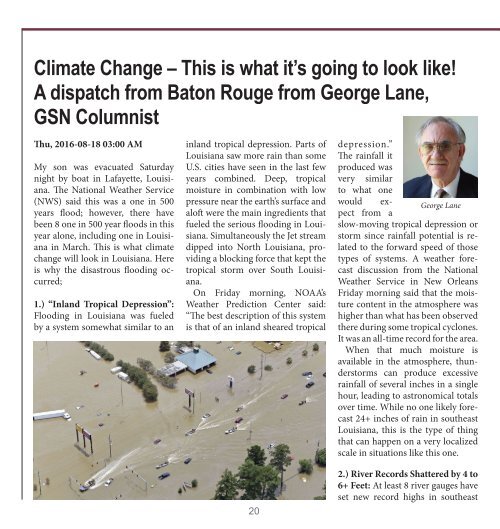Government Security News August Digital Edition
Create successful ePaper yourself
Turn your PDF publications into a flip-book with our unique Google optimized e-Paper software.
Climate Change – This is what it’s going to look like!<br />
A dispatch from Baton Rouge from George Lane,<br />
GSN Columnist<br />
Thu, 2016-08-18 03:00 AM<br />
My son was evacuated Saturday<br />
night by boat in Lafayette, Louisiana.<br />
The National Weather Service<br />
(NWS) said this was a one in 500<br />
years flood; however, there have<br />
been 8 one in 500 year floods in this<br />
year alone, including one in Louisiana<br />
in March. This is what climate<br />
change will look in Louisiana. Here<br />
is why the disastrous flooding occurred;<br />
1.) “Inland Tropical Depression”:<br />
Flooding in Louisiana was fueled<br />
by a system somewhat similar to an<br />
inland tropical depression. Parts of<br />
Louisiana saw more rain than some<br />
U.S. cities have seen in the last few<br />
years combined. Deep, tropical<br />
moisture in combination with low<br />
pressure near the earth’s surface and<br />
aloft were the main ingredients that<br />
fueled the serious flooding in Louisiana.<br />
Simultaneously the Jet stream<br />
dipped into North Louisiana, providing<br />
a blocking force that kept the<br />
tropical storm over South Louisiana.<br />
On Friday morning, NOAA’s<br />
Weather Prediction Center said:<br />
“The best description of this system<br />
is that of an inland sheared tropical<br />
20<br />
depression.”<br />
The rainfall it<br />
produced was<br />
very similar<br />
to what one<br />
would expect<br />
from a<br />
George Lane<br />
slow-moving tropical depression or<br />
storm since rainfall potential is related<br />
to the forward speed of those<br />
types of systems. A weather forecast<br />
discussion from the National<br />
Weather Service in New Orleans<br />
Friday morning said that the moisture<br />
content in the atmosphere was<br />
higher than what has been observed<br />
there during some tropical cyclones.<br />
It was an all-time record for the area.<br />
When that much moisture is<br />
available in the atmosphere, thunderstorms<br />
can produce excessive<br />
rainfall of several inches in a single<br />
hour, leading to astronomical totals<br />
over time. While no one likely forecast<br />
24+ inches of rain in southeast<br />
Louisiana, this is the type of thing<br />
that can happen on a very localized<br />
scale in situations like this one.<br />
2.) River Records Shattered by 4 to<br />
6+ Feet: At least 8 river gauges have<br />
set new record highs in southeast
















